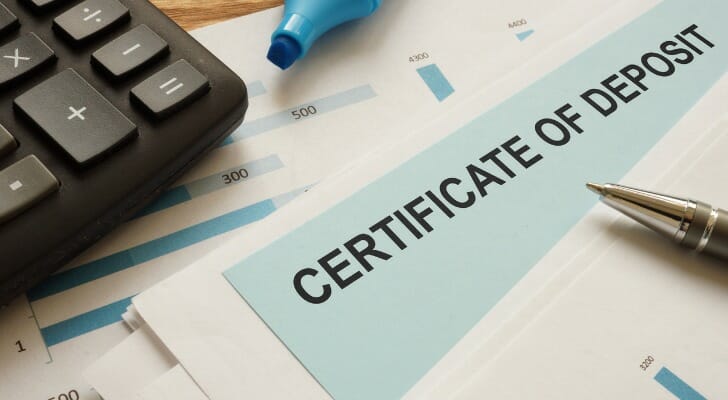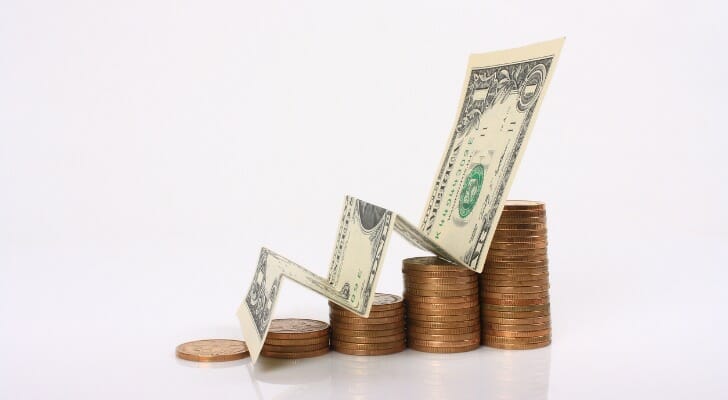Certificates of deposits are some of the safest investments you can make. They are not dependent on the stock market, they are protected by deposit insurance and they have clear terms that you understand going in. A bump-up CD, also known as a step-up CD, has the potential to offer the same high level of stability while also allowing you to take advantage of a rising-rate environment. Let’s take a look at what bump-up CDs are, how they work and if they’re the best option for you.
If you’d like personalized advice on your savings and investment strategy, consider working with a financial advisor.
Bump-Up CD Definition
First, let’s define what a regular CD is. A CD is a savings account that holds your money for an agreed-upon period of time. At the end of that time period, your money is released to you along with an agreed-upon amount of interest. If you withdraw your money before the agreed-upon time is up, you’ll pay a penalty.
To calculate how much interest you could earn with a CD, try using SmartAsset’s CD calculator.
A bump-up CD operates on the same principle, but you have the option to raise the interest rate during the CD’s lifespan — to bump it up, if you will. Some CDs will only offer one opportunity to bump up your rate, while others may have longer lifespans and offer more than one chance to raise it.
A bump-up CD is designed to allow customers to take advantage of rising CD rates without having to cash out their CD, swallow the penalty and put their money back into a new, higher-interest CD. But because of the option to bump up, this kind of CD usually offers a lower starting rate than a traditional CD.
How Does a Bump-Up CD Work?
Let’s look at a simple example of a bump-up CD. You put your money in a bump-up CD with a 24-month maturity date and a starting interest rate of 1.5%. At the 12-month mark, the CD rates at the bank that holds your CD rise to 2%, and you use your bump-up option to raise your rate to 2% for the remaining 12 months.
This simplified example of a bump-up CD shows some of the positives of a bump-up CD: You can get an improved interest rate in one of the safest and most predictable savings vehicles that exist.
Is a Bump-Up CD Right for You?

While a CD is an excellent way to earn interest and a bump-up CD might sound like a great way to maximize your earnings, it might not be the best choice in all scenarios. Let’s take a look at three things to consider before you put your money in a bump-up CD.
- Bump-up CDs may not out-earn traditional CDs. As mentioned above, while bump-up CDs offer the option to raise rates, they often start you out at a lower rate overall. Say in the above scenario, where a bump-up CD allowed you to go from a 1.5% interest rate to a 2% interest rate halfway through the lifespan of the CD, you had the option of taking out a traditional CD for the same term at a 1.9% interest rate. You would earn less over the life of the bump-up CD than you would have just going with the traditional CD.
- Interest rates may continue to rise after your bump-up. Let’s say that in the above scenario, a month after you took your bump-up, rates rise again to 3%. Interest rates are difficult to predict, and if your timing is off, it could mean sticking out several months at a less competitive rate.
- The terms of a CD may not be right for you. CDs, whether bump-up or not, aren’t for everyone. CDs overall may not offer enough flexibility for some savers due to the fact your money is locked away for a set amount of time, and if you need to access it, you will likely lose a good deal of the interest you earned by having it in a CD in the first place. CDs can also require high minimum deposit amounts to lock in competitive interest rates, which again might be too illiquid for some.
The Bottom Line

A bump-up CD can be a great choice in a rising interest rate environment, allowing you to take advantage of a secure savings option while still having the opportunity to bump-up your rate. On the other hand, bump-up CDs can leave you behind if rates continue to rise after your bump-up and have other limitations that might not make them right for everyone.
Tips for Savings
- For more help determining which CDs or other investment vehicles are right for you, consider working with a financial advisor. Finding a financial advisor doesn’t have to be hard. SmartAsset’s free tool matches you with up to three vetted financial advisors who serve your area, and you can have a free introductory call with your advisor matches to decide which one you feel is right for you. If you’re ready to find an advisor who can help you achieve your financial goals, get started now.
- Putting your money in a savings account rather than a CD may be a better choice if you want more flexibility. Just make sure you look for a high-yield savings account so that your money is still working for you.
- Interested in seeing how quickly your savings will grow over time? Check out SmartAsset’s savings calculator to see how big your savings account will be in a few years, how interest can impact your savings and more.
Photo credit: ©iStock/LUHUANFENG, ©iStock/Andrii Dodonov, ©iStock/Kunakorn Rassadornyindee
